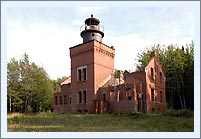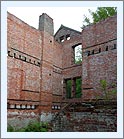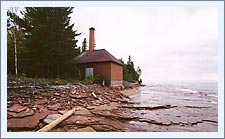|
Historical Information

By the 1880's, both the lumber and copper industries were experiencing
phenomenal growth along the shores of Lake Superior. To support the
increase in maritime traffic servicing this boom, the Lighthouse Board
turned its attention to ensuring that there was a continuous string of
navigational aids in place along the southern shore of the lake.
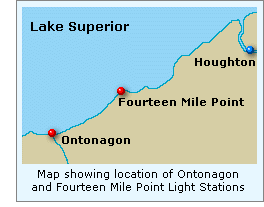 While a lighthouse had been established
on the pier at Ontonagon in 1866, and the Upper Entrance to the Portage
Lake ship Canal had been served with a light since 1874, the forty two
miles of uninhabited coast between the two stations remained as yet
unmarked. While a lighthouse had been established
on the pier at Ontonagon in 1866, and the Upper Entrance to the Portage
Lake ship Canal had been served with a light since 1874, the forty two
miles of uninhabited coast between the two stations remained as yet
unmarked.
Searching for an appropriate location
for the new coast light, the Board determined that the establishment of
a station in the area of Fourteen-Mile Point, would not only create the
desired unbroken line of Light visibility, but would also serve to mark
the important turning point for Ontonagon-bound traffic. The Board
petitioned Congress for an appropriation for construction of the
station, and received a favorable response on March 3, 1893 when $20,000
was appropriated for the project.
The Board responded quickly to the
appropriation, obtaining title to fifty acres of land on Fourteen-Mile
Point from the State of Michigan on July 21 of that same year.
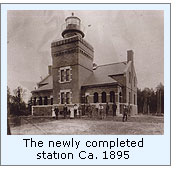 That
fall, a small work crew arrived at the point and began construction of a
temporary work shelter for the construction crew, which was scheduled to
arrive the following spring. On their departure, they left a single
workman who had been tasked with clearing an opening in the dense forest
over the winter months. While we do not know the name of the solitary
workman, he was evidently an extremely industrious and self-motivated
individual, since on the arrival of the lighthouse tender AMARANTH on
May 10th that spring, it was found that he had single-handedly cleared
almost ten acres of trees and brush. That
fall, a small work crew arrived at the point and began construction of a
temporary work shelter for the construction crew, which was scheduled to
arrive the following spring. On their departure, they left a single
workman who had been tasked with clearing an opening in the dense forest
over the winter months. While we do not know the name of the solitary
workman, he was evidently an extremely industrious and self-motivated
individual, since on the arrival of the lighthouse tender AMARANTH on
May 10th that spring, it was found that he had single-handedly cleared
almost ten acres of trees and brush.
The AMARANTH anchored offshore, and
over the next four days the 30-man construction crew unloaded almost 450
tons of construction materials, which the vessel had transported from
the Detroit lighthouse depot.
Work
began on May 14th, and progressed rapidly under the watchful supervision
of Major M. B. Adams, the Eleventh District's Chief Engineer, and by
summer's end, one of the largest and most magnificent coastal lights on
all the Great Lakes took shape on Fourteen Mile Point.
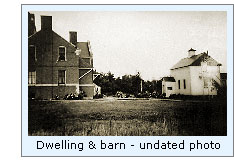 The main two-story lighthouse was
constructed in duplex style to provide quarters for both the Head keeper
and his First Assistant. The imposing structure was constructed with
double walls with an air space in between for both strength and
insulation. The integral square tower was located centrally in the
building's front fašade, and stood fifty-five feet in height, capped by
a circular watchroom with round portholes through which the keepers
could keep a watchful eye on passing vessels and weather conditions. The main two-story lighthouse was
constructed in duplex style to provide quarters for both the Head keeper
and his First Assistant. The imposing structure was constructed with
double walls with an air space in between for both strength and
insulation. The integral square tower was located centrally in the
building's front fašade, and stood fifty-five feet in height, capped by
a circular watchroom with round portholes through which the keepers
could keep a watchful eye on passing vessels and weather conditions.
In turn, a decagonal cast iron lantern
was hoisted to the walkway on top of the watchroom. Equipped with a Fourth
Order Fresnel lens, the clear lens featured red flash panels,
and was designed to rotate through a clockwork mechanism, to display a
fixed white light with a flash if red every twenty seconds. Each light
station was provided with a unique flash pattern, or signature, designed
to let mariners quickly determine the identity of each station along
their passage.
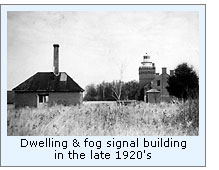 Close to the shore, approximately a
hundred feet west of the main structure, a brick fog-signal building
took shape. Equipped with dual 10-inch fog whistles, it was designed to
emit an ear-shattering scream to be heard miles across the lake,
providing a bearing to blinded vessels during thick weather. The two
thirsty Fitzgibbons steam engines powering these whistles received an
ample supply of water by way of a windmill-powered pump, obtaining its
water supply from beneath a protective crib constructed just offshore. Close to the shore, approximately a
hundred feet west of the main structure, a brick fog-signal building
took shape. Equipped with dual 10-inch fog whistles, it was designed to
emit an ear-shattering scream to be heard miles across the lake,
providing a bearing to blinded vessels during thick weather. The two
thirsty Fitzgibbons steam engines powering these whistles received an
ample supply of water by way of a windmill-powered pump, obtaining its
water supply from beneath a protective crib constructed just offshore.
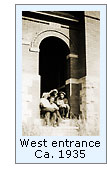 Work turned to the construction of a
wood-framed Second Assistant Keepers dwelling, brick oil storage shed,
wooden barn and boathouse. With the construction work completed at the
station, the station's head keeper Thomas Doody exhibited the light for
the first in October 15, 1894. Work turned to the construction of a
wood-framed Second Assistant Keepers dwelling, brick oil storage shed,
wooden barn and boathouse. With the construction work completed at the
station, the station's head keeper Thomas Doody exhibited the light for
the first in October 15, 1894.
Keepers at Fourteen-Mile Point
faithfully continued their daily vigil every year for the following
forty-six years until the station was automated through the installation
of an acetylene gas lighting system in 1940. At this time, the buildings
were gutted of any valuable equipment and furniture, and the station was
boarded-up. Responsibility for the acetylene system's maintenance was
transferred to the keepers of the Ontonagon Light, who were required to
make monthly trips via trail or water to inspect the light's condition,
and make any necessary repairs.
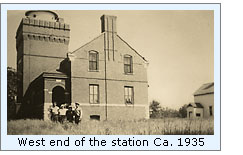 The station continued to exhibit its
light until 1945, when it was decided that combination of the increased
use of radio beacons and changes in shipping patterns had rendered the
station obsolete. The acetylene light was exhibited from the tower for
the last time on the night of April 3. With the arrival of a Coast Guard
crew on the beach the following day, the magnificent Fresnel lens and
acetylene illuminating apparatus were removed from the tower, and crated
for storage. With the departure of the crew, Fourteen-Mile Point was
abandoned to weather the elements, and the property was transferred to
the Department of the Interior. The station continued to exhibit its
light until 1945, when it was decided that combination of the increased
use of radio beacons and changes in shipping patterns had rendered the
station obsolete. The acetylene light was exhibited from the tower for
the last time on the night of April 3. With the arrival of a Coast Guard
crew on the beach the following day, the magnificent Fresnel lens and
acetylene illuminating apparatus were removed from the tower, and crated
for storage. With the departure of the crew, Fourteen-Mile Point was
abandoned to weather the elements, and the property was transferred to
the Department of the Interior.
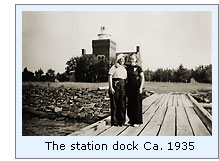 At some time thereafter, the station
property was sold into private ownership. It would appear that the
owners did not realize the historical value of their purchase, since
they did nothing to maintain or protect the buildings, and their
condition deteriorated rapidly. At some time thereafter, the station
property was sold into private ownership. It would appear that the
owners did not realize the historical value of their purchase, since
they did nothing to maintain or protect the buildings, and their
condition deteriorated rapidly.
While it might appear that the remote
location might serve to deter vandalism, the station suffered the
ultimate insult on July 30 1984, when unknown individuals torched the
main structure, destroying everything combustible. A passing boater
reported the fire, but the Coast Guard could not make the 42-mile trip
in time to save the structure.
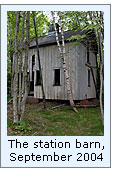 With the roof and floors significantly
damaged, and the structural integrity compromised, it appeared likely
that the brick walls would begin began to crumble, and the once mighty
structure was destined to become one with the ground. With the roof and floors significantly
damaged, and the structural integrity compromised, it appeared likely
that the brick walls would begin began to crumble, and the once mighty
structure was destined to become one with the ground.
During the early 90's, Don Hermanson of
Keweenaw Video Productions, along with John and Susan Hatch went
together to purchase the lighthouse property. Don has information about
their accomplishments since taking over the station on his Keweenaw
Video Productions Website.
We hope that they have the necessary
time and resources to at least stabilize the structure, if not to
restore it to its prior original glory. We wish them the best of luck in
their endeavor.

Keepers of
this Light

Click here
to see a complete listing of all Fourteen Mile Point Light keepers
compiled by Phyllis L. Tag of Great Lakes Lighthouse Research.

Finding this Light

Fourteen Mile Point Light Station is located on private property some 14
miles east of Ontonagon. The old trail the keepers used has
long since overgrown and has become impenetrable. While views of the station
can be had from a boat, and the station is accessible to snowmobiles,
the station is in tenuous condition and is privately owned. Thus, we ask that anyone attempting to
photograph the station honor the privacy of the owners and take only
pictures and leave only footprints..

Reference Sources

Lighthouse Board Annual Reports, 1892, 1893 & 1894.
Scott's New Coast Pilot, 1909.
Photograph courtesy of Michigan State Archives.
Photographs courtesy of Ontonagon Historical Society.
Photographs courtesy of the Edna Dahl Strang collection.
Northern Lights, Charles K. Hyde, 1995.
Keeper listings for this light appear
courtesy of Great
Lakes Lighthouse Research
|
